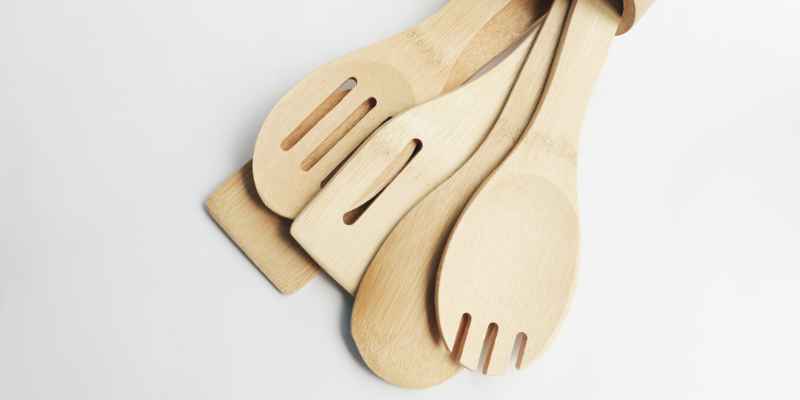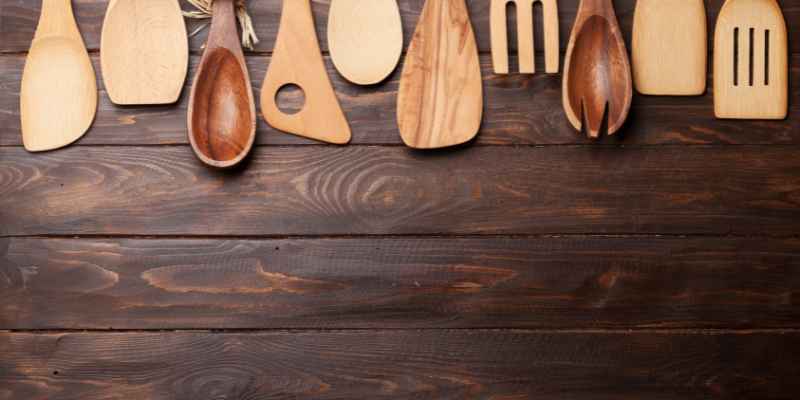For utensils, the best wood to use is hard maple due to its durability and resistance to moisture. Hard maple is known for its longevity and ability to withstand repeated use, making it an ideal choice for utensils that will be in constant contact with food and water.
Its tight grain also ensures that it won’t absorb flavors or odors, maintaining the integrity of the utensils over time. Additionally, hard maple’s light color and smooth texture add a touch of elegance to any kitchen. So, if you’re considering making or purchasing wooden utensils, hard maple is the top choice to ensure longevity and functionality.
Characteristics Of Ideal Wood For Utensils
Choosing the best wood for your kitchen utensils is crucial for their longevity and safety. The ideal wood for utensils exhibits specific characteristics that make it suitable for food preparation and serving. Let’s explore the key attributes to look for when selecting wood for your utensils.
Durability
Durability is paramount when considering wood for utensils to ensure they can withstand daily use without splintering or breaking easily.
Non-reactivity
Non-reactivity is essential to prevent the wood from interacting with acids or other substances in food, maintaining the food’s flavor and safety.

Top 5 Wood Options
When it comes to choosing the best wood for utensils, it can be quite overwhelming considering the vast array of options available in the market. However, certain types of wood stand out due to their durability, grain pattern, and resistance to moisture. In this article, we will explore the top 5 wood options for utensils, including Maple, Cherry, Beech, Olive Wood, and Walnut. Let’s dive in and discover the unique characteristics each wood type brings to the table.
1. Maple
Maple wood is a popular choice for utensils due to its light color, fine grain, and strength. It is known for its durability and resistance to moisture, making it ideal for kitchen utensils that often come into contact with water. The tight grain of maple wood prevents food particles from getting trapped, ensuring a hygienic surface for preparing meals. Additionally, the smooth texture allows for comfortable grip and easy cleaning, making it the preferred choice for many chefs and home cooks alike.
2. Cherry
Cherry wood is another excellent option for utensils due to its rich reddish-brown hue and beautiful grain patterns. It not only adds an aesthetic appeal to your kitchen but also offers durability and strength. This wood type is known for its natural resistance to moisture, which helps prevent warping or cracking over time. The smooth surface of cherry wood makes it easy to maintain and clean, ensuring the longevity of your utensils. Moreover, its mild scent adds a pleasant aroma to your culinary experiences.
3. Beech
Beech wood is highly regarded for its light color and pronounced grain pattern, offering a classic and timeless look to your utensils. It is a hardwood known for its durability and excellent resistance to water, making it suitable for long-term use in the kitchen. Beech utensils are appreciated for their sturdiness, which allows for efficient stirring, flipping, and serving. With proper care, beech wood utensils can last for years without showing signs of wear and tear.
4. Olive Wood
Olive wood is not only renowned for its unique and intricate grain patterns but also for its strength and durability. This wood type is dense and resistant to water, making it perfect for cutting boards, spatulas, and other utensils that often come into contact with moisture. Olive wood’s natural oils provide a distinctive aroma that adds to the overall sensory experience while preparing meals. Additionally, the smooth surface of olive wood utensils ensures a comfortable grip and prevents food from sticking, making them a preferred choice among discerning chefs and culinary enthusiasts.
5. Walnut
Walnut wood is prized for its dark, rich color and exceptional strength. It offers a sophisticated and elegant touch to any kitchen decor. The deep, straight-lined grain pattern of walnut wood creates a stunning visual appeal. In addition to its beauty, walnut wood boasts excellent durability and is resistant to water. This makes it an ideal choice for utensils that require frequent washing and exposure to moisture. Whether you are stirring, tossing, or serving, walnut utensils are sure to enhance your cooking experience.
Comparative Analysis
Delve into a detailed Comparative Analysis to determine the Best Wood for Utensils, evaluating factors like durability, sustainability, and food safety. Finding the ideal wood species is crucial for ensuring longevity and safety in kitchen utensils.
When selecting the best wood for utensils, it’s crucial to understand the unique strengths and weaknesses of each wood type. This comparative analysis will provide valuable insights to help you make an informed decision. Let’s delve into the strengths and weaknesses of each wood type.
Strengths And Weaknesses Of Each Wood Type
Beech Wood
- Durable and resistant to splintering
- Smooth and fine-grained texture for easy carving
- Prone to warping or cracking if not properly maintained
Oak Wood
- Highly durable and resistant to moisture
- Distinctive grain pattern adds aesthetic appeal
- Heavy and dense, which can make carving more challenging
Maple Wood
- Hard and dense, perfect for heavy-duty use
- Resistant to staining and absorbing odors
- May be more difficult to carve due to its density
Walnut Wood
- Deep, rich color and attractive grain pattern
- Excellent resistance to moisture and odors
- Relatively softer compared to other hardwoods, making it more susceptible to dents
Maintenance Tips
Proper maintenance is essential to prolong the lifespan and keep the best wood for utensils in good condition. Implement these effective maintenance tips to ensure your utensils remain durable and functional for years to come.
Cleaning
When cleaning wooden utensils, hand wash them with mild soap and warm water. Avoid soaking them for long periods or placing them in the dishwasher, as this can cause the wood to warp or crack. After washing, thoroughly dry the utensils with a towel to prevent moisture damage.
Seasoning
To maintain the wood’s quality, seasoning is crucial. Apply food-safe oil such as mineral oil or coconut oil to the utensils regularly to prevent them from drying out. This will also help in creating a protective barrier and enhance the natural luster of the wood.
Environmental Considerations
When it comes to choosing the best wood for utensils, it’s important to consider the environmental impact of your decision. By selecting wood that is both sustainable and biodegradable, you can make a positive contribution to the planet. In this section, we will explore these environmental considerations in detail.
Sustainability
One of the key factors to consider when choosing wood for utensils is its sustainability. Sustainable wood is sourced from forests that are responsibly managed, ensuring that trees are replanted and biodiversity is preserved. By opting for utensils made from sustainable wood, you are supporting the conservation of our natural resources.
Not all woods are equally sustainable, however. Some types of wood, such as bamboo and beech, are known for their fast growth rates and can be harvested without causing significant harm to the environment. Others, like mahogany and teak, take years to mature and may have adverse effects on their ecosystems when harvested unsustainably.
Considering the sustainability of the wood used for your utensils helps ensure that you are making an eco-friendly choice. By using wood from responsibly managed forests, you can have confidence in the positive environmental impact of your utensils.
Biodegradability
In addition to sustainability, biodegradability is another important consideration when choosing the best wood for utensils. Utensils made from biodegradable wood will naturally break down over time, reducing waste and minimizing their impact on the environment.
Unlike utensils made from synthetic materials, wood utensils can be composted at the end of their life cycle. This means that they will not contribute to the ever-growing problem of plastic pollution in our oceans and landfills. Choosing biodegradable wood utensils is a responsible choice for both your own household and the planet as a whole.
When disposing of wood utensils, it is important to remember to compost them in a designated composting facility or your own backyard compost. This will help ensure they are properly broken down and returned to the earth without any harmful effects.
Final Thoughts
Looking for the best wood for utensils? Consider maple, cherry, or walnut. These woods are durable, resistant to moisture, and safe for food use, making them ideal choices for crafting high-quality kitchen utensils. Opt for sustainable and food-safe wood to ensure the longevity and safety of your utensils.
Choosing The Best Wood For Your Utensils
Wooden utensils are a popular choice due to their natural beauty and durability. Selecting the right type of wood is crucial to ensure the longevity of your utensils. Remember to consider both the hardness and porosity of the wood to find the best option.
Opting for hardwoods like maple, cherry, or walnut will provide a strong and long-lasting utensil. Softwoods like pine should be avoided as they are more prone to splintering and damage. Always prioritize untreated woods to prevent harmful chemicals from leaching into your food.
In conclusion, choosing the best wood for your utensils requires attention to detail and consideration of the wood’s properties. Investing in high-quality wood will not only enhance your cooking experience but also contribute to a sustainable and eco-friendly kitchen.

Frequently Asked Questions For Best Wood For Utensils
What Are The Best Woods For Making Utensils?
When it comes to making utensils, hardwoods such as maple, cherry, and walnut are typically considered the best choices. These woods are durable, food-safe, and resistant to moisture, making them ideal for kitchenware. They also offer attractive natural colors and grains.
Is It Safe To Use Pine Wood For Utensils?
No, pine wood is not recommended for making utensils. While it may be inexpensive and readily available, pine is soft, porous, and tends to splinter easily. Additionally, the resin in pine can transfer an unpleasant flavor to food, making it unsuitable for cooking and serving utensils.
What Are The Advantages Of Using Bamboo For Utensils?
Bamboo is a popular choice for utensils due to its eco-friendly and sustainable nature. It is highly durable, lightweight, and naturally antimicrobial, making it ideal for kitchenware. Additionally, bamboo utensils are easy to clean, resistant to staining, and gentle on cookware surfaces, making them a versatile option.
How Can I Maintain Wooden Utensils For Longevity?
To prolong the life of wooden utensils, it’s essential to hand wash them with mild detergent and dry them immediately. Regular oiling with food-grade mineral oil or beeswax helps prevent drying and cracking. Avoid soaking wooden utensils and never place them in the dishwasher to maintain their natural beauty and functionality.
Conclusion
When choosing the best wood for utensils, it is important to consider factors such as resistance to moisture, durability, and food safety. With various options available, including bamboo, cherry, and olive wood, each type has its own unique qualities. By selecting the right wood, you can enhance your cooking experience and ensure the longevity of your utensils.
So, go ahead and make an informed decision that suits your specific needs and enjoy the benefits of using high-quality wooden utensils in your kitchen.


